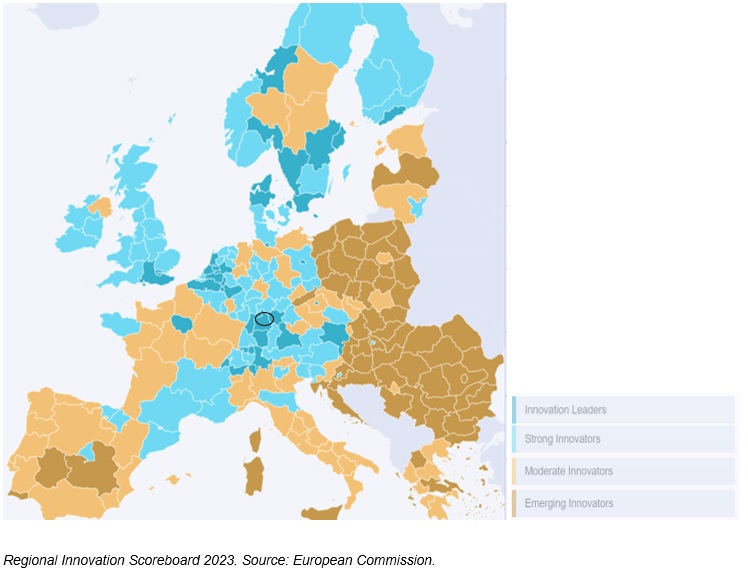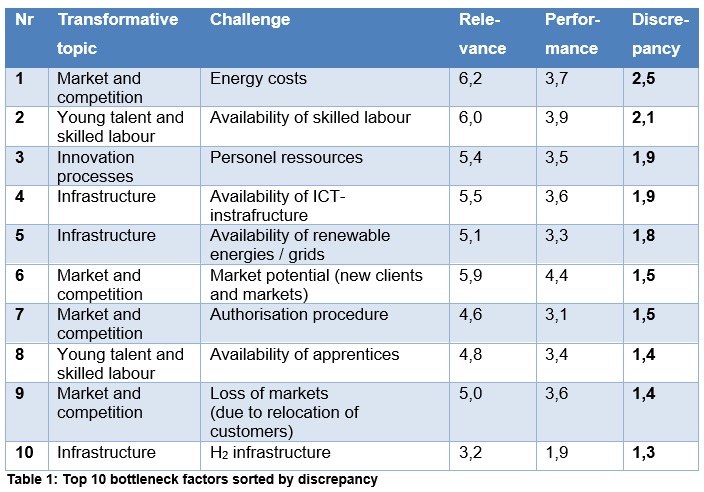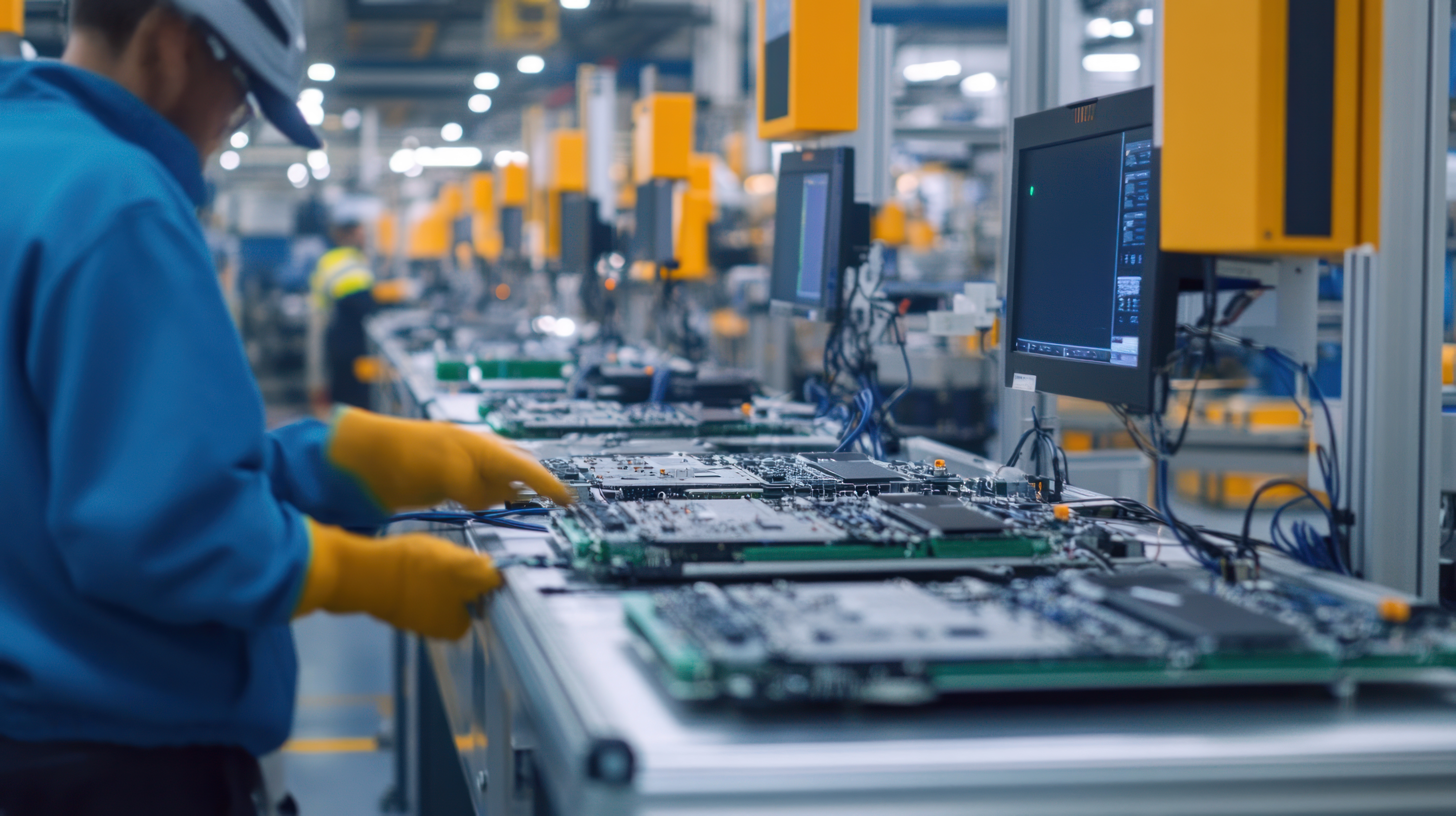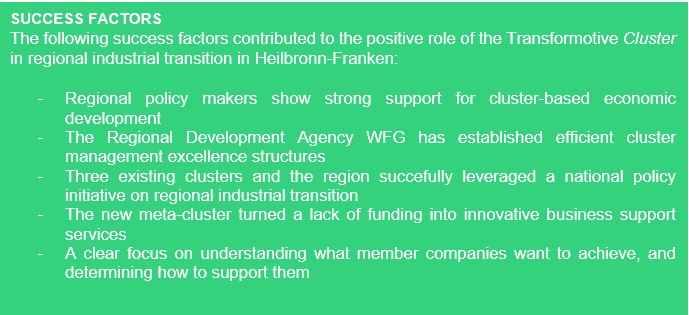Tackeling Industrial Transition in the Regional Automotive Industry
Summary: The Heilbronn-Franken region in Baden-Württemberg is a vibrant economic area encompassing cities like Heilbronn, Schwäbisch Hall, Künzelsau, and Crailsheim. This region combines urban and rural elements, balancing high quality of life with economic dynamism. It boasts a robust industrial base with key sectors including mechanical engineering, automotive, and food production. The presence of numerous “Hidden Champions” highlights its strength in niche markets, and major corporations like Audi, Bosch, and Lidl further bolster its economic profile.
Historically, the region has developed a dense network of world market leaders and is recognised for its industrial ecosystems. Key sectors include metal and automotive industries, food production, and information services. Strategic challenges for the region include digitalisation, sustainability, and a shortage of skilled labor. Companies must adapt to technological changes, invest in green technologies, and address workforce issues. The automotive sector faces a major transformation with the shift to electric and connected vehicles.
The Economic Development Agency Heilbronn (WFG-Heilbronn) plays a pivotal role in cluster-based economic development, focusing on innovation, market expansion, and supporting SMEs. Notable initiatives include the TransformotiveDIALOG meta-cluster, which merges several networks to drive industry transformation. The WFG-Heilbronn is exploring ways to enhance cluster utilisation and policy influence, aiming to position the region as a leader in sustainable and technological advancements. Despite challenges, the region’s strategic focus on research, industry collaboration, and innovation promises continued economic vitality.
The Heilbronn-Franken Economic Region

The Heilbronn-Franken region is a significant economic area in Baden-Württemberg. It extends over the northern part of the state and includes the cities of Heilbronn, Schwäbisch Hall, Künzelsau, and Crailsheim. With a mix of urban and rural areas, the region offers a unique balance between high quality of life and economic dynamism.
Heilbronn-Franken is characterised by a strong industrial base, with mechanical engineering, the automotive industry, and food production being among the leading sectors. The region is also home to many “Hidden Champions”, which are medium-sized enterprises but also global leaders in their niche markets. Especially the Heilbronn economic area, consisting of the city of Heilbronn and the Heilbronn district containing around 11,500 chamber-affiliated companies with over 166,000 employees, makes it one of Germany’s strongest economic locations. Large corporations like Audi, Bosch, and Lidl contribute to this, as does the mid-sized sector, which includes an above-average number of Hidden Champions in this economic area.
The region’s economy is supported by a well-developed network of educational and research institutions that closely collaborate with industry to foster innovation and train skilled professionals. This synergy between industry and education has contributed to the creation of a dynamic economic environment.

The region's existing industrial base is the result of a historical development and covers a broad spectrum. Measured against the number of its inhabitants, the region of Heilbronn-Franken offers the highest density of world market leaders in Germany.[1] Given the high share of employees working in cluster companies, Heilbronn-Franken is also considered an exemplary cluster-region.
The most important sectors by the number of jobs[2] are the metal industry including mechanical engineering and the manufacture of fabricated metal products, automotive engineering including suppliers, the food industry including food and animal feed production as well as information services.
Compared to other regions, the innovative strength of Heilbronn-Franken occupies a middle-ranking position. Although the region's innovative performance is below average according to the state wide innovation index, Heilbronn-Franken represents a strong region with respect to an active innovation development.[3] Important locations for research and development are Abstatt, Untergruppenbach and Hardthausen-Lampoldshausen.
Until about ten years ago, there were hardly any R&D activities in the region. However, this has drastically changed, making it the nationwide leader in terms of R&D personnel, mainly due to research-oriented companies. There is now a strong focus on research, with various universities specialising in different areas. In particular, the „Bildungscampus“ of the Dieter Schwarz Foundation has played a significant role in transforming the region into a model for research and innovation by attracting institutions such as the Technische Universität München (TUM), Duale Hochschule Baden-Württemberg Heilbronn (DHBW Heilbronn), Ferdinand Steinbeis Institute, Fraunhofer Institutes IAO and ISI, and Hochschule Heilbronn (HHN).
Additionally, the establishment of the Eidgenössische Technische Hochschule (ETH) Zürich is currently in progress, as they are setting up an education and research center in Heilbronn.[1]
[1] A team in Zurich for the education and research centre in Heilbronn – Staffnet | ETH Zurich
[1] https://www.heilbronn-franken.com/de/wirtschaft/firmen-branchen/weltmarktfuehrer.html
[2]In terms of the number of jobs subject to social insurance contributions, excluding those in trade, construction and the public sector.
[3]Statistisches Landesamt Baden-Württemberg, Statistisches Monatsheft Baden-Württemberg 9/2024: Innovationsindex 2024

The Heilbronn-Franken region faces a number of challenges that, at the same time, also present opportunities: Digitalisation, demographic change, and the transition to a sustainable economy require continuous adaptation and innovation. A recent study on the topic of industrial transition identified the following challenges in relation to the relevance and performance of transformation topics in the region from the perspective of companies.
Based on these challenges, the following fields of action were derived for the region:
- Active support in the recruitment of young talent and skilled labour
- Promotion of innovation and initiation of university-industry cooperation
- Networking of regional players
- Targeted support with funding
- Addressing key transformation issues for regional companies
The automotive industry has a long tradition in the city and district of Heilbronn and has developed into a key industry in this region. More than 26,000 people are employed directly in the automotive industry. In addition, there are thousands of jobs directly linked to the automotive industry that are located at suppliers. These include a number of engineering service providers, electronics manufacturers, parts producers, software houses, logistics companies and surface treatment specialists. The entire value chain in the automotive segment is therefore covered.
However, the shift from combustion engines to electric drives, the integration of software and IT, and the development of new mobility solutions present major transformation challenges for local companies. They must reposition themselves and develop innovative solutions to remain competitive. In particular, suppliers with a strong technological focus on the combustion engine pressure to change industries and adapt and sell their products outside the automotive sector. Yet while the imminent transformation in the regional automotive sector is challenging, there are promising and innovative approaches among companies and the scientific community.
The Heilbronn economic area is distinguished by a high density of specialised networks and cluster initiatives that are closely linked and specifically promote various industries. These networks play a central role in enhancing the region's competitiveness and innovation capabilities. Among the key networks in the Heilbronn economic area are AutomotiveDIALOG, PlasticsDIALOG, and MetalsDIALOG. These networks were established by the Economic Development Agency Heilbronn (WFG) to support companies in their respective industries. AutomotiveDIALOG specifically targets automotive suppliers in the region, while PlasticsDIALOG encompasses 38 players in the plastics industry, offering support particularly in strategy, marketing, efficiency, and innovation. Similarly, MetalsDIALOG brings together 45 companies from the metal industry, providing assistance in the same areas.
In 2022, these three networks were merged into the TransformotiveDIALOG meta-cluster as part of a larger policy initiative by the Federal Ministry for Economic Affairs and Climate Action (BMWK) supporting the transformation of the German automotive industry. The merger into a unified meta-cluster demonstrates the region’s flexibility and adaptability in addressing its strategic challenges. The strategic focus on research, sustainability, and cross-industry collaboration thereby makes the Heilbronn economic area one of Germany's leading economic locations.
The Economic Development Agency Heilbronn (WFG-Heilbronn) plays a central role in the cluster-based industrial transition of the Heilbronn-Franken region. The agency was established to promote the region as an attractive business location and to support companies in their development and expansion.
WFG-Heilbronn is committed to the sustainable economic development of the region. It promotes innovation, supports companies in accessing new markets, and strengthens the regional economy through targeted support measures and projects. A particular focus is on supporting small and medium-sized enterprises (SMEs), which form the backbone of the regional economy. The shareholders of WFG are the city and district of Heilbronn, the city of Neckarsulm, IG Metall and the municipalities of the district of Heilbronn.
WFG sees its mission not only in economic promotion but also in improving the quality of life in the region. This includes creating attractive jobs, promoting the education and qualification of the workforce, and supporting the integration of sustainability into the business models of companies.
TransformotiveDIALOG – A new Meta-Cluster

In 2022, the three existing regional clusters AutomotiveDIALOG, PlasticsDIALOG, and MetalsDIALOG were merged into the TransformotiveDIALOG meta-cluster as part of the federal TRANSFORMOTIVE programme, funded by the Federal Ministry for Economic Affairs and Climate Action (BMWK) with 7 million euros. The goal is to drive transformation and innovation in the relevant industries, mainly automotive industries.
The consolidation of the three clusters into TransformotiveDIALOG reflected the need to combine the strengths of various industries and create synergies to ensure the region's long-term competitiveness.
The Heilbronn-based TransformotiveDIALOG meta-cluster has turned into a key player within the regional innovation ecosystem. It has a clear vision to become “the starting and finishing point for manufacturing companies in the Heilbronn economic region” when it comes to corporate, technological and organisational development. In order to do so, the cluster aims to support regional companies in addressing the challenges of digital and green transition. This includes adapting to new technological developments, integrating digital technologies into production, and promoting sustainable business models.
The cluster plays a central role in connecting local companies, research institutions, and educational institutions to foster innovation and strengthen the competitiveness of the regional economy. Through targeted projects and collaborations, it facilitates the creation of new and the strengthening of existing value chains.
Today, the cluster counts 126 active members, including 7 large companies (including 1 OEM), 105 small and medium-sized enterprises (SMEs), 3 universities, 3 research and technology centres, one trade union, an employers' organisation and a private regional development association. Although membership is currently free, fees are expected to be introduced in 2026. The cluster is fully operated by WFG. Its management board consists of executives from companies in the regional automotive, metal and plastics industries. The board meets between one and three times over the course of a year to shape the strategic development of the network. Moreover, an advisory board, which consists of the shareholders of the WFG, as well as representatives of the regional Alliance for Transformation (BfT), including representatives from regional science and industry entities, provides strategic guidance on shaping the network's innovation agenda.
The TransformotiveDIALOG cluster is designed to offer a range of services and activities in three strategic areas: 1. Information, 2. Networking, and 3. Knowledge building with the overall objective to maximise added value for members and promote network exchange. The cluster’s targeted service portfolio includes:
- Annual network meetings: Regular events facilitate face-to-face meetings, information sharing and collaborations between members.
- Joint trade fair stands: Members are given the opportunity to present their products and services to a wide audience at relevant industry trade fairs at joint stands.
- Network-related online community: An online platform promotes the continuous exchange of knowledge, discussions and collaboration even between physical meetings. International exchange is promoted through the use of matchmaking services and the online community.
- Meetings at member companies: Network meetings can also take place directly at member companies to provide insights into operational processes and resources.
- International delegation trips: Organised meetings at international companies and events.
- Events to promote exchange beyond Heilbronn and to utilise synergies.
- Active co-design of funding applications: Members can participate in the conceptualisation of funding applications for the TransformotiveDIALOGUE.
The cluster management has established professional structures, processes, and tools that underpin these services, leading to consistent positive developments within the cluster.
The cluster’s operational structure and its embedding in the WFG facilitates an effective implementation of targeted cluster services. Due to limited financial resources and a lack of dedicated budgets, however, the cluster’s emphasis is on supporting businesses rather than directly funding transformative activities at company level. This approach has led to some significant successes in acquiring funds for local companies.
Moreover, a key achievement has been the development of new services to enhance regional resilience. This process involved identifying relevant topics, formulating a strategy, and systematically addressing each point. As a result, for example, cluster members have shown significant recovery from the COVID-19 pandemic.
A general strength of the cluster lies in its use of an advanced monitoring tool for quantifying impact and the formalisation of strategies. The cluster's impact on individual companies is evident in increased efficiency and market expansion. Regular assessments every six months help to maintain momentum and address emerging challenges, thus ensuring that the cluster remains responsive to the needs of its members and the broader economic environment.
Lessons Learned and Transferability

The experiences and lessons learned from the TransformotiveDIALOG meta-cluster in Heilbronn-Franken offer valuable insights for other clusters aiming to drive regional industrial transformation. A key takeaway is the importance of leveraging a robust network of specialised clusters to foster innovation and adapt to industry changes. The Heilbronn-Franken region’s success underscores the effectiveness of merging existing networks into a coherent meta-cluster initiative, as demonstrated by the creation of TransformotiveDIALOG. This consolidation has enabled the region to address industrial challenges more comprehensively and efficiently, providing a model for other clusters looking to integrate and amplify their impact.
Another crucial lesson is the role of strong, strategic management in steering cluster activities. The Heilbronn-Franken cluster has shown that understanding the needs of companies and applying strategic tools can significantly enhance support for business goals and market positioning. Effective portfolio management, characterised by shared responsibilities among cluster members, is essential for sustaining dynamic and responsive support.
The cluster’s approach to addressing financial limitations by focusing on business support rather than direct transformation funding also offers a practical strategy. Despite limited budgets, the cluster has succeeded in acquiring funds and developing new services to boost regional resilience, demonstrating that targeted business support can be a viable alternative to extensive transformative funding.
Furthermore, the success of the Heilbronn-Franken cluster highlights the importance of continuous evaluation and adaptation. Regular assessments help maintain momentum and address emerging challenges, ensuring that the cluster remains responsive to the needs of its members and the broader economic environment.
In terms of transferability, other clusters can benefit from adopting a similar approach to integrating networks, leveraging strategic management tools, and focusing on business support amid financial constraints. By emphasising these practices, clusters in different regions can enhance their effectiveness in driving industrial transition and fostering economic growth.